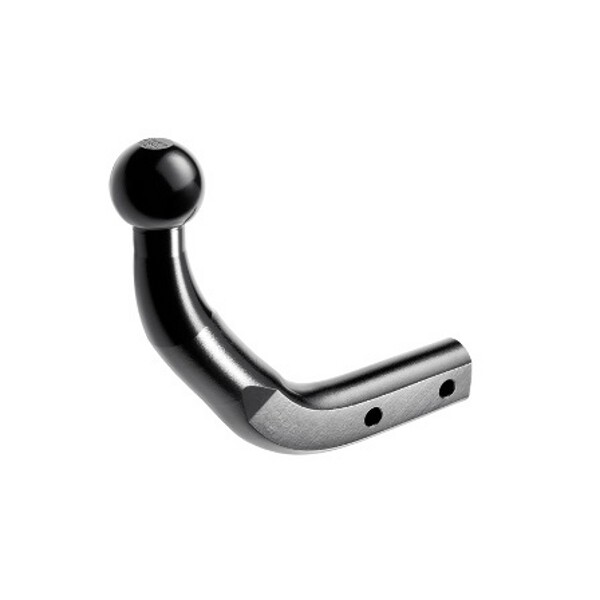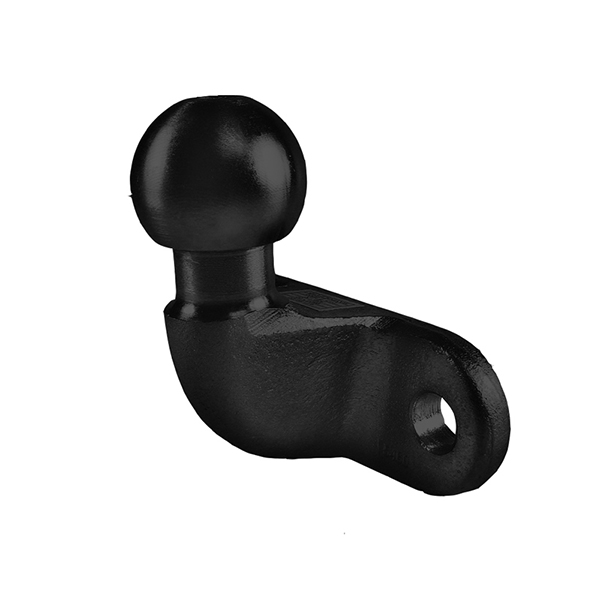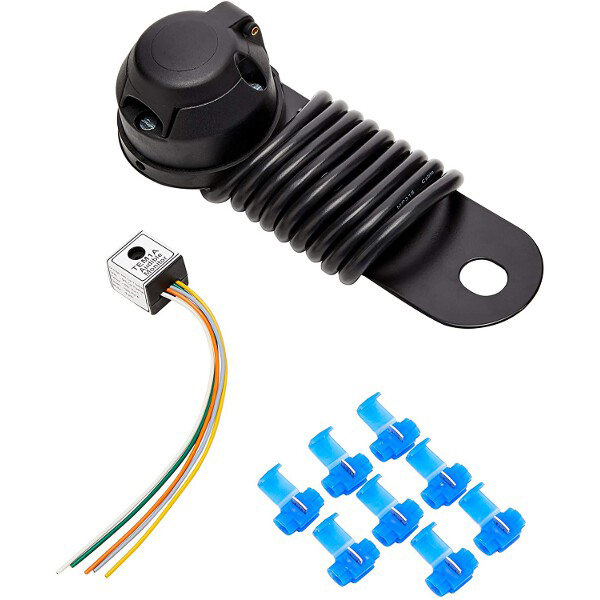Choosing the right tow bar for your car is vital for your safety and that of fellow drivers. Our guide below covers everything you need to know, including the different types of tow bars available and the cost of fitting a tow bar.
Once you have found the best tow bar for your vehicle, discover our range of tow bars at affordable prices at Euro Car Parts.
What Are The Main Types Of Tow Bars?
All tow bars are either fixed or detachable and available in two styles: swan neck and flange.
Swan-Neck Tow Bars
Commonly used in EU countries, the swan-neck tow bar is an all-in-one device where the tow ball and neck are all part of the same frame.
Swan-neck tow bars are less versatile than flange tow bars, as you cannot tow and attach a cycle simultaneously.
Pros of a fixed swan-neck tow bar
- Thinner and sleeker than flange tow bars.
- Suitable for most towing applications.
- Less likely to be detected by parking sensors.
- Compatible with all ball-mount cycle carriers.
- Competitively priced compared to the detachable variant.
- Can be used with friction stabilisers.
Cons of a fixed swan-neck tow bar
- Can’t be used to tow luggage and carry a bicycle at the same time.
- Not as adaptable as flange tow bars/unable to add height adjusters or couplings.
- Can be more expensive than a flange tow bar.
Fixed swan-neck tow bars are suitable for:
- Towing a caravan or trailer or ball mounted cycle carriers.
Fixed swan-neck tow bars are unsuitable for:
- Towing luggage and attaching a bicycle simultaneously.
- Drivers who want to detach the tow bar after use.
Pros of a detachable swan-neck tow bar
- Clean, flushed look when neck is detached.
- Less likely to set parking sensors off.
- Can carry many types of bicycle carrier.
- Compatible with friction style stabilisers.
Cons of a detachable swan-neck tow bar
- Lost tow bar necks are expensive to replace.
- Height of tow bar can’t be adjusted.
Detachable swan-neck tow bars are suitable for:
- Most users wanting to tow or attach a bicycle.
- Drivers who require more space behind the car.
Detachable swan-neck tow bars are unsuitable for:
- Drivers wanting to adjust height of the tow bar or add additional tow ball.
- Users needing to tow luggage and attach a bicycle simultaneously.
Flange Tow Bar
The flange tow bar is the most commonly used tow bar type in the UK. The tow ball is attached to the bar via two 24mm bolts, although this can extend to four bolts on certain models.
The versatility of the flange tow bar plays a major part in its popularity. It is capable of being fitted with various accessories to modify its use for different purposes; be it to attach a bumper protector or height-adjusting couplings.
Pros of a fixed flange tow bar
- Can be used with
various different accessories to customise its use:
- Tow bar and pin system to attach trailers and generators.
- Bumper-protector plates.
- Height-adjustment couplings.
- Tend to be cheaper than swan-neck tow bars.
- AL-KO stabilisers can be used when upgrading the tow ball.
Cons of a fixed flange tow bar
- More likely to set off parking sensors.
- Due to the tow bar not being flush to the car, there is increased chance of collision with the tow bar.
Fixed flange tow bars are suitable for:
- Drivers seeking customisation and increased utility when towing or attaching equipment.
- Users on a budget.
Fixed flange tow bars are unsuitable for:
- Drivers with limited parking space behind vehicle.
- Drivers seeking a flush, clean look.
Pros of a detachable flange tow bar
- Has all the customisation potential of a fixed flange tow bar.
- Detachable tow bar neck frees up space behind the vehicle.
- Compatible with friction style stabilisers.
- Less likely to set off parking sensors, as neck is removable.
Cons of a detachable flange tow bar
- Lost tow bar necks are expensive to replace.
Detachable flange tow bars are suitable for:
- Drivers seeking customisation and increased utility when towing or attaching equipment.
- Users who need parking space behind vehicle.
- Drivers who don’t require a tow bar attached 24/7.
Detachable flange tow bars are unsuitable for:
- Drivers on a budget, as they are more expensive than the fixed variant and are costly to replace.
Choosing Your Tow Bar Electric System
All tow bars must be installed with an electrical system by UK law. The electrics will provide lighting and other functionality to the connected caravan, trailer or carrier. They also sync the tow bar system to the security features within the car.
Tow bar electric kits come in three variants:
- 7-pin – can power lights on caravans, trailers and cycle carriers. Can’t power internal appliances.
- 7-pin twin – usually installed alongside a regular 7-pin kit. Can power external lights and internal appliances.
- 13-pin – can power all external and internal electrical appliances. All UK caravans since 2008 are constructed with a 13-pin connector as standard.
If you only need to power the external lighting of a caravan or carrier, a 7-pin connector may be suitable for you. Otherwise, a 7-pin/7-pin twin combo or 13-pin connectors will provide power to everything you are towing.
Fitting Your Tow Bar
In terms of fitting your own tow bar, it’s a job that you should only do if you are confident. If you’re not entirely certain on what to do, you should go to a professional mechanic.

Fitting a tow bar takes around an hour, depending on the tow bar. It’s advised to have access to either a ramp, an inspection pit or a couple of jacks. This is so you can safely work underneath the vehicle.
Before you start, read the instructions fully. This is because manufacturers have different ways of constructing their tow bars, and how they fix onto your car.
Then, offer up the tow bar to the vehicle, so you can see if any car parts may be in the way. At this stage, some people experience issues with their car exhausts. If this happens, you may have to remove these car parts, so you can fit the tow bar. Then reattach them once the tow bar is in position.
When you have got clear access to the car chassis, make sure to follow each instruction step-by-step. As mentioned earlier, each tow bar is different, and affected by different vehicle models too.
It is also advised that you don’t fix any bolts or fastenings too tightly. Until the tow bar is fully attached, you may have to go back and loosen them slightly.
Other Important Considerations When Choosing A Tow Bar
Weight – the main thing that you need to consider is just how much weight you are likely to be towing. If you know that you will need to a trailer, then you could go for a smaller tow bar than for a caravan. However, remember to factor in the weight of the contents too.
Towing Wing Mirrors – ensure that you can see around whatever you are towing. If you are towing a trailer this will be easy due to the relative height of the trailer; but for caravans and bike racks it’s much more difficult to see what is behind you. As such you need to make sure that you have fitted towing mirrors to your existing wing mirrors. In the majority of cases they simply clip on to the edge of your wing mirrors and they instantly provide a much greater field of vision.
Number Plate – a trailer should also have a clear number plate that matches the vehicle registration. This is so that police and ANPRs can check that you are road legal, that the trailer is safe for towing. The plate should be fitted to the rear of the caravan or trailer.
License to Tow – learner drivers cannot legally tow anything on a British road and depending on when you received your driving license will determine just what you can tow and how heavy it can be – so be sure to consult your license and even contact the DVLA for clarification before you tow for the first time.
For more information on a wide range of car parts including headlights and tow bars; don’t hesitate to get in touch with the experts at Euro Car Parts. We can help you to understand the best parts and accessories for all makes and models, and will even deliver the parts to your door.





